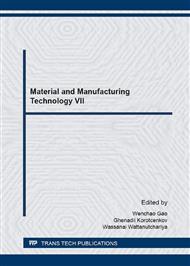p.187
p.191
p.196
p.201
p.206
p.211
p.216
p.223
p.230
Effect of Alkaline Activation on Low Grade Natural Kaolin for Synthesis of Zeolite A
Abstract:
The conventional technique to synthesizes zeolite A from kaolin is calcination. However, this technique has one drawback since, the impurities in kaolin, such as muscovite and quartz, remain. Therefore, the hydrothermal process without calcination is used to synthesize high purity zeolite A. Hydrothermal synthesis without calcination can be separated into two steps, namely first and second hydrothermal steps. Alkaline activation reaction in the first hydrothermal step was used to study the effect of NaOH concentration ranging from 4M, 6M, 8M, 10M to 12M at 200°C for 3 hours. In this step, sodium aluminosilicate (cancrinite and nepheline hydrate) was produced and then dissolved in HCl. After filtration, the impurity was removed, and adjusted for neutral pH of 7 to form amorphous aluminosilicate gel. For the second hydrothermal step, amorphous gel was mixed with NaOH (1-4M) to form zeolite A at 90°C for 3 days. The x-ray diffraction (XRD) and Scanning Electron Microscope (SEM) were used for characterization.
Info:
Periodical:
Pages:
206-210
Citation:
Online since:
September 2016
Keywords:
Price:
Сopyright:
© 2016 Trans Tech Publications Ltd. All Rights Reserved
Share:
Citation:


